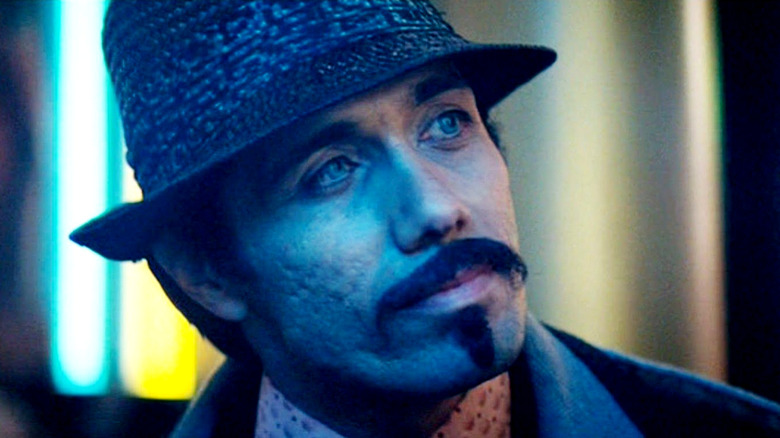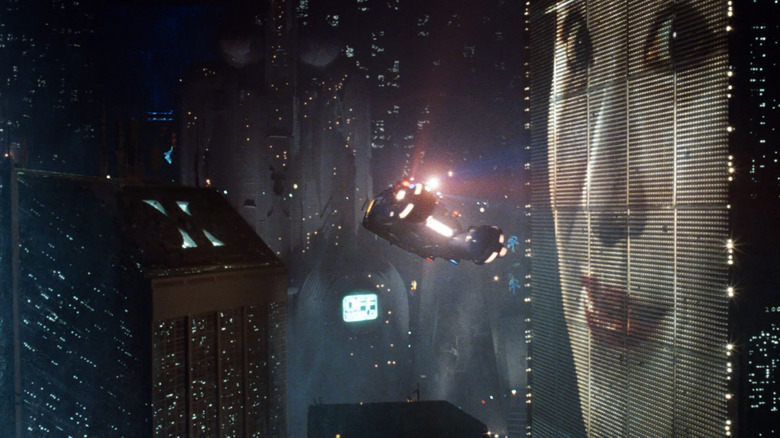The Blade Runner Actor Responsible For The Sci-Fi Movie's Signature Style
Science fiction fans will mostly remember Edward James Olmos for playing Admiral William Adama in the reimagined "Battlestar Galactica." A space opera, "Galactica" follows a fleet of starships fleeing from humanity's vengeful robotic creations, the Cylons. An actor of Olmos' caliber in the lead role raised the show around him — and funnily enough, he'd faced off with androids long before he took command of the Galactica.
Olmos previously played Eduardo Gaff in Ridley Scott's cult classic sci-fi noir "Blade Runner." Gaff is an LAPD officer hunting down escaped Replicant androids alongside antihero lead, Rick Deckard (Harrison Ford). And the story goes that Olmos had another role to play when he made a suggestion about the movie's production design.
"Battlestar Galactica" co-creator Ronald D. Moore appeared on "The Sackhoff Show" this past March, hosted by former "Galactica" star Katee Sackhoff. During the episode, Moore discussed his first meeting with Olmos, who was drawn to the project because it reminded him of "Blade Runner."
When "Blade Runner" came up, Olmos told Moore that he was the one who suggested the movie's future Los Angeles be steeped in Japanese culture. The idea, which didn't seem far off then in 1982, was that Japan would take over as a dominant superpower, exporting people and culture around the world. Moore was disbelieving and "filed it away" that Olmos was the kind of guy to self-aggrandize... until years later, when he was watching a "Blade Runner" boxset and heard Ridley Scott credit Olmos for the idea to make 2019 Los Angeles look like a Japanese city.
Olmos was born and raised in Los Angeles, so he brought personal experience that Scott (being an Englishman) lacked. Both Sackhoff and Moore praised Olmos for "having his finger on the pulse" of his hometown.
Blade Runner's Los Angeles has become the default cyberpunk setting
Los Angeles in "Blade Runner" is filled with neon signs written in kanji. That unique palette of darkness and artificial advertising lights everywhere suggests a miserable world, but one where technology and capitalism keep moving forward. The urban aesthetic isn't the only sign of Japanese influence in "Blade Runner." There's a prominent shot of a huge billboard showing a projection of a Geisha, Deckard is shown eating at a noodle stand, etc.
"Blade Runner" was off in predicting Japanese global dominance. In the 1990s, Japan experienced an economic downturn, or "the lost decade." However, "Blade Runner" became such a famous film that its production design is wholly synonymous with "cyberpunk." Stories in that genre will thus often include heavy Asian influence in their future fashions, languages, etc.
It doesn't hurt that the other foundational cyberpunk movie, "Ghost in the Shell," is an anime; the overlap between anime fans and cyberpunk fans is pretty wide. Anime such as "Cowboy Bebop" have an obvious reason to show a future where Asian cultures are ascendant, being made in Japan and all. Yet you also see this trend in Western shows, such as the short-lived space series "Firefly," where the U.S. and China folded into a single nation to colonize a new solar system.
That said, this trend of Japan-flavored cyberpunk has also attracted claims of cultural appropriation and orientalism. Both "Blade Runner" and its sequel "Blade Runner 2049" feature few characters of Asian descent. The main characters of "Firefly" speak Chinese, but none of them are actually Chinese. The "love" for Asian culture that's onscreen rings hollow when the focus is still on white characters living in these supposedly Asian-dominated worlds.

